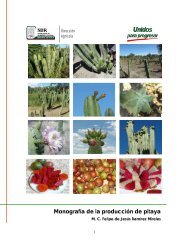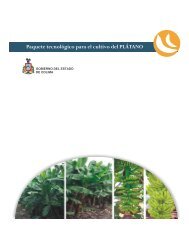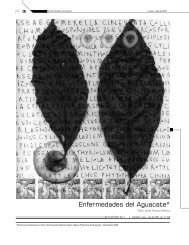BIOLOGIA Y MANEJO DE ANTRACNOSIS EN CÍTRICOS.pdf
BIOLOGIA Y MANEJO DE ANTRACNOSIS EN CÍTRICOS.pdf
BIOLOGIA Y MANEJO DE ANTRACNOSIS EN CÍTRICOS.pdf
You also want an ePaper? Increase the reach of your titles
YUMPU automatically turns print PDFs into web optimized ePapers that Google loves.
antibiosis, parasitismo, competencia, resistencia sistémica adquirida, protección cruzada e<br />
hipovirulencia (Ownley y Windham, 2004). Al respecto, Kupper et al., (2003) evaluó el<br />
efecto de diferentes aislamientos de los antagonistas Bacillus subtilis y Trichoderma spp.<br />
bajo condiciones de laboratorio y campo. Los resultados en árboles de naranja dulce Cv.<br />
„Natal‟, demostraron la efectividad de algunos tratamientos de B. subtilis y T. aureoviridae<br />
en reducir el porcentaje de flores con síntomas de la enfermedad en comparación al<br />
tratamiento testigo. Sin embargo, el corto período de incubación del patógeno desde la<br />
llegada del conidio hasta el establecimiento de la infección limita la efectividad de los<br />
antagonistas por el tiempo reducido en que C. acutatum permanece vulnerable.<br />
Literatura consultada<br />
Agostini, J.P., and Timmer, L.W. 1994. Population dynamics and survival of strains of<br />
Colletotrichum gloeosporioides on citrus in Florida. Phytopathology 82: 1377-1382.<br />
Agostini, J.P., Gottwald, T.R., and Timmer, L.W. 1993. Temporal and spatial dynamics of<br />
postbloom fruit drop in Florida. Phytopathology 82: 1377-1382.<br />
Agostini, J.P., Timmer, L.W. and Mitchell, D. J. 1992. Morphological and pathological<br />
characteristics of strains of Colletotrichum gloeosporioides from citrus. Phytopathology 82:<br />
1377-1382.<br />
Bailey, J.A., and Jeger, M.J. 1992. Colletotrichum: biology, pathology and control. CAB<br />
International. Wallingford, U.K. 388 p.<br />
Brown, J.K.M. and Hovmøller, M.S. 2002. Aerial dispersal of pathogens on the global and<br />
continental scales and its impact on plant disease. Science 297:537-541.<br />
Brown, A.E., Sreenivasaprasad, S., and Timmer, L.W. 1996. Molecular characterization of<br />
slow-growing orange and key lime anthracnose strains of Colletotrichum from citrus as C.<br />
acutatum. Phytopathology 86:523-527.<br />
Chung, K.-R., Shilts, T., Ertürk, Ü., Timmer, L.W., and Ueng, P.P. 2003. Indole derivatives<br />
produced by the fungus Colletotrichum acutatum, causing lime anthracnose and postbloom<br />
fruit drop of citrus. FEMS Microbiology Letters 226:23-30.<br />
Dodd, J.C., Estrada, A., and Jeger, M.J. 1992. Epidemiology of Colletotrichum<br />
gloeosporioides in the tropics. In: Colletotrichum: biology, pathology and control. Bailey,<br />
J.A. and Jeger, M.J. (Eds.). p. 308-325. CAB International. Wallingford, U.K.<br />
Fagan, H.J. 1979. Postbloom fruit drop, a new disease associated with a form of<br />
Colletotrichum gloeosporioides. Annals of Applied Biology 91:13-20.<br />
Fagan, H.J. 1984. Postbloom fruit drop of citrus in Belize: I. Disease epidemiology.<br />
Turrialba 34(2):179-186.







